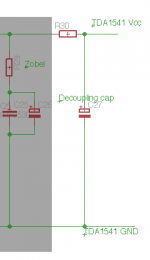The RC Zobel is local termination to the Bib and should stay local to the bib. If it can be close enough to both on dual role for decoupling the 1541 too, so much to the better. But is a 4u7 plastic capacitor enough for that chip?
Thanks! I will be using BiB.
As my supplies used to be off-board, I had some decoupling caps very (3 mm) close to the supply pins of the TDA1541 (1 uF SMD film + 33uF BG + 270uF Oscon SEPC). Now that I will be placing the shunt regulators on the same pcb as the dac circuit, how can I best arrange this decoupling?
The BiB uses 2 caps on the output (part of the Zobel). Should I just place these caps very close to the chip and omit the decoupling caps I use now? OR should I use the caps on the output of the supply reg and in addition use a decoupling cap close to the chip? OR should I use the current decoupling caps as a replacement for the zobel caps of the shunt reg?
Salas already suggested to put a 100 ohm resistor at the output of the shunt reg when other decoupling caps are present close to the ICs.
I would leave the output El cap OR the Zobel (MKT+ R) close to the shunt device (BJT or MosFet)
Yes, but no C26. That one is the ''plan B'' capacitor in the Bib.
So the electrolyte is "plan B", the MKT is standard?
As far as I could read earlier in the thread, the BJT version is recommended for high frequency circuits, so I would use that for my 11 MHz clock.
For the inputs on the DAC (digital, analog and analog/digital), is there a recommendation on which version to use? Certainly MOSFET for the analog supply to the chip for lowest Zo.... The digital circuits are probably better off with the bjt-version...?
For the inputs on the DAC (digital, analog and analog/digital), is there a recommendation on which version to use? Certainly MOSFET for the analog supply to the chip for lowest Zo.... The digital circuits are probably better off with the bjt-version...?
So the electrolyte is "plan B", the MKT is standard?
Yes, its role is described in the guide in appendix 4. Did you read the 1.1 Bib guide?
As far as I could read earlier in the thread, the BJT version is recommended for high frequency circuits, so I would use that for my 11 MHz clock.
For the inputs on the DAC (digital, analog and analog/digital), is there a recommendation on which version to use? Certainly MOSFET for the analog supply to the chip for lowest Zo.... The digital circuits are probably better off with the bjt-version...?
Also a big C101 polar cap value is recommended when applied on clocks. Due to sensitivity in 1/f noise of those circuits. Your other choices are good.
Also a big C101 polar cap value is recommended when applied on clocks. Due to sensitivity in 1/f noise of those circuits. Your other choices are good.
Hi Salas,
Is BJT 1/f noise lower than MOSFET?
Its mainly coming from the voltage reference. The shunt element contributes residual due to no voltage gain. Still a BJT is naturally less of a noise source than a Mosfet. The error amp is low noise BJT anyway.
It has the voltage reference on its input and contradicts deviations in the output by reverse driving the shunt element that adds or subtracts current on the output node fighting those load inflicted deviations.
So it controls current output in order to maintain the constant vout.
It has a major role IMO.
Is there an equivalent part / circuit in the reflektor ?
It has a major role IMO.
Is there an equivalent part / circuit in the reflektor ?
The current mirror. But that one reflects current changes instead of amplifying voltage changes.
🙂
So in this case, the mirror is the "key" to the overall performance. I must build another pair of those, using the correct BJT´s.
So in this case, the mirror is the "key" to the overall performance. I must build another pair of those, using the correct BJT´s.
Thanks Salas!
And now the most silly question of them all: How should I deal with Remote Sensing in this case? First off, I don't really know what it does, nor did google give me good input....
Should I just connect +S and +F?
And now the most silly question of them all: How should I deal with Remote Sensing in this case? First off, I don't really know what it does, nor did google give me good input....
Should I just connect +S and +F?
- Status
- Not open for further replies.
- Home
- Amplifiers
- Power Supplies
- The simplistic Salas low voltage shunt regulator
